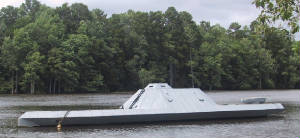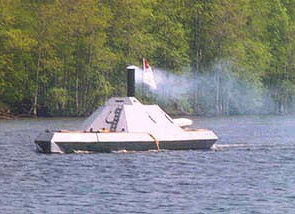|
CSS ALBEMARLE IRONCLAD RAM: HISTORY HOMEPAGE
| CSS Albemarle (Replica) |

|
| (Photographed in 2003) |
As a result of operations on the high seas, on rivers, and in bays and harbors, the U.S. Navy was a
decisive factor in the Civil War's outcome. The Union Navy blockaded some three thousand miles of Confederate coast from Virginia
to Texas in a mammoth effort to cut off supplies, destroy the Southern economy, and discourage foreign intervention. The Confederate
Navy, however, was determined to break the Federal blockade, and, under the most adverse circumstances, was able
to construct the most formidable warships of its era. Although the Confederacy was unable to match the Union's manufacturing
capability, it managed to produce a new ship, the powerful ironclad, also known as the ironclad ram. This is the story of
one such ironclad - the CSS Albemarle. Before the Albemarle's demise, she would unleash havoc on the Union Navy and destroy
29 of its ships.
| CSS Albemarle (Replica) |

|
| Civil War Ironclad ram Albemarle |
| Battle of Albemarle North Carolina Civil War Map |

|
| Civil War Ironclad ram Albermarle |
Recommended Reading: The Hunt for the Albemarle:
Anatomy of a Gunboat War (Hardcover). Description:
On a muddy waterway, once called the River of Death, James Cooke and Charles Flusser met again after parting
when the Civil War started. Once both navy lieutenants, they now were the opponents in naval warfare. Confederate Navy Lieutenant
James Cooke had as many years of active naval service as Charles Flusser had years of living. Cooke was a devoted family man
while Flusser was a bachelor with a mind for young Southern women, whiskey, cigars, fast horses, and early promotion. Continued
below...
The Confederate
ironclad Albemarle was the key to the river wars in North Carolina. Flusser's
search for this ship would determine the success or failure of the Union navy in securing the North Carolina coast and
rivers. James Cooke and the Confederates knew their only chance to break the blockade was with the new ironclad. The Hunt
for the Albemarle
is the dramatic story of these two men and their destiny. Both of these men shared one common characteristic. Each was willing
to die for the cause he believed was right.
Recommended
Reading: A History of Ironclads: The Power of Iron over Wood. Description: This
landmark book documents the dramatic history of Civil War ironclads and reveals how ironclad warships revolutionized naval
warfare. Author John V. Quarstein explores in depth the impact of ironclads during the Civil War and their colossal effect
on naval history. The Battle of Hampton Roads was one of history's greatest naval engagements. Over the course of two days
in March 1862, this Civil War conflict decided the fate of all the world's navies. It was the first battle between ironclad
warships, and the 25,000 sailors, soldiers and civilians who witnessed the battle vividly understood what history would soon
confirm: wars waged on the seas would never be the same. Continued below…
About the Author: John V. Quarstein is an award-winning author and historian. He is director
of the Virginia
War Museum in Newport News and chief historical advisor for The Mariners' Museum's new USS Monitor Center
(opened March 2007). Quarstein has authored eleven books and dozens of articles on American, military and Civil War history,
and has appeared in documentaries for PBS, BBC, The History Channel and Discovery Channel.
Recommended
Reading: Iron Afloat: The Story of the Confederate Armorclads. Description: William N. Still's book is rightfully referred to as the standard of Confederate Naval history.
Accurate and objective accounts of the major and even minor engagements with Union forces are combined with extensive background
information. This edition has an enlarged section of historical drawings and sketches. Mr. Still explains the political background
that gave rise to the Confederate Ironclad program and his research is impeccable. An exhaustive literature listing rounds
out this excellent book. While strictly scientific, the inclusion of historical eyewitness accounts and the always fluent
style make this book a joy to read. This book is a great starting point.
Recommended
Reading: Civil War Ironclads: The U.S. Navy and Industrial Mobilization (Johns Hopkins
Studies in the History of Technology). Description: "In this impressively researched and broadly conceived study, William
Roberts offers the first comprehensive study of one of the most ambitious programs in the history of naval shipbuilding, the
Union's ironclad program during the Civil War. Perhaps more importantly, Roberts also provides
an invaluable framework for understanding and analyzing military-industrial relations, an insightful commentary on the military
acquisition process, and a cautionary tale on the perils of the pursuit of perfection and personal recognition." - Robert
Angevine, Journal of Military History "Roberts's study, illuminating on many fronts, is a welcome addition to our understanding
of the Union's industrial mobilization during the Civil War and its inadvertent effects on the postwar U.S. Navy." - William
M. McBride, Technology and Culture"
Recommended
Reading: Naval Strategies of the Civil War: Confederate Innovations and Federal Opportunism. Description: One of the most overlooked aspects of the American Civil War is the
naval strategy played out by the U.S. Navy and the fledgling Confederate Navy, which may make this the first book to compare
and contrast the strategic concepts of the Southern Secretary of the Navy Stephen R. Mallory against his Northern counterpart,
Gideon Welles. Both men had to accomplish much and were given great latitude in achieving their goals. Mallory's vision of
seapower emphasized technological innovation and individual competence as he sought to match quality against the Union Navy's
(quantity) numerical superiority. Welles had to deal with more bureaucratic structure and to some degree a national strategy
dictated by the White House. Continued below...
The naval blockade
of the South was one of his first tasks - for which he had but few ships available - and although he followed the national
strategy, he did not limit himself to it when opportunities arose. Mallory's dedication to ironclads is well known, but he
also defined the roles of commerce raiders, submarines, and naval mines. Welles's contributions to the Union effort were rooted
in his organizational skills and his willingness to cooperate with the other military departments of his government. This
led to successes through combined army and naval units in several campaigns on and around the Mississippi River.
Recommended
Reading: A History of
the Confederate Navy (Hardcover). From
Publishers Weekly: One of the most prominent European scholars of the Civil War weighs in with a provocative revisionist study
of the Confederacy's naval policies. For 27 years, University of Genoa history professor Luraghi (The Rise and Fall of the
Plantation South) explored archival and monographic sources on both sides of the Atlantic to develop a convincing argument
that the deadliest maritime threat to the South was not, as commonly thought, the Union's blockade but the North's amphibious
and river operations. Confederate Navy Secretary Stephen Mallory, the author shows, thus focused on protecting the Confederacy's
inland waterways and controlling the harbors vital for military imports. Continued below…
As a result,
from Vicksburg
to Savannah to Richmond, major
Confederate ports ultimately were captured from the land and not from the sea, despite the North's overwhelming naval strength.
Luraghi highlights the South's ingenuity in inventing and employing new technologies: the ironclad, the submarine, the torpedo.
He establishes, however, that these innovations were the brainchildren of only a few men, whose work, although brilliant,
couldn't match the resources and might of a major industrial power like the Union. Nor did
the Confederate Navy, weakened through Mallory's administrative inefficiency, compensate with an effective command system.
Enhanced by a translation that retains the verve of the original, Luraghi's study is a notable addition to Civil War maritime
history. Includes numerous photos.
Recommended
Reading: Naval Campaigns
of the Civil War. Description: This analysis
of naval engagements during the War Between the States presents the action from the efforts at Fort Sumter during the secession
of South Carolina in 1860, through the battles in the Gulf of Mexico, on the Mississippi River, and along the eastern seaboard,
to the final attack at Fort Fisher on the coast of North Carolina in January 1865. This work provides an understanding of
the maritime problems facing both sides at the beginning of the war, their efforts to overcome these problems, and their attempts,
both triumphant and tragic, to control the waterways of the South. The Union blockade, Confederate privateers and commerce
raiders are discussed, as is the famous battle between the Monitor and the Merrimack.
Continued below…
An overview
of the events in the early months preceding the outbreak of the war is presented. The chronological arrangement of the campaigns
allows for ready reference regarding a single event or an entire series of campaigns. Maps and an index are also included.
About the Author: Paul Calore, a graduate of Johnson and Wales University,
was the Operations Branch Chief with the Defense Logistics Agency of the Department of Defense before retiring. He is a supporting
member of the U.S. Civil War Center and the Civil War Preservation Trust and has also written Land Campaigns of the Civil
War (2000). He lives in Seekonk, Massachusetts.
|

